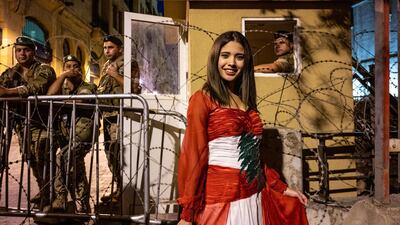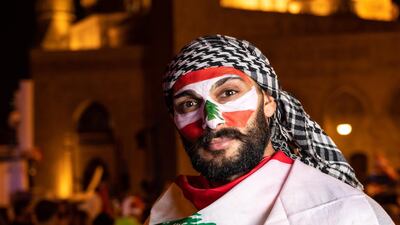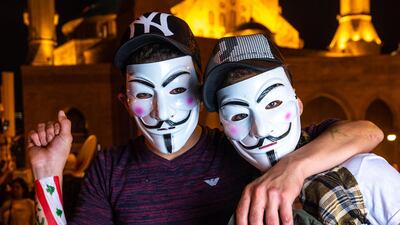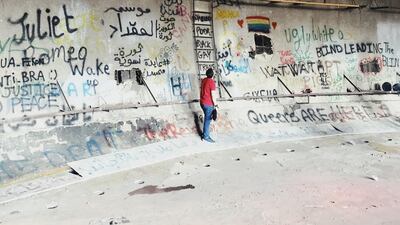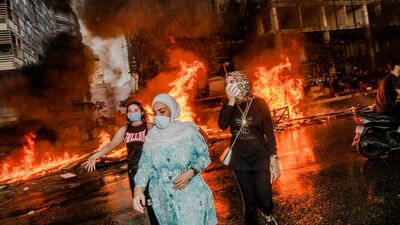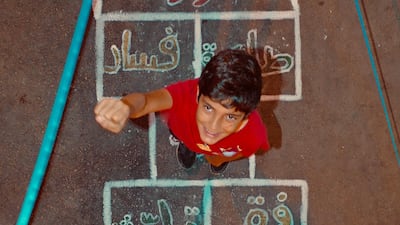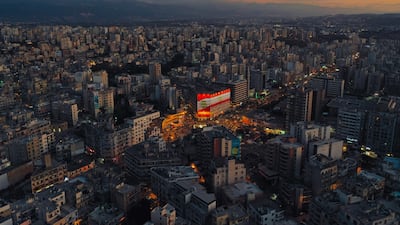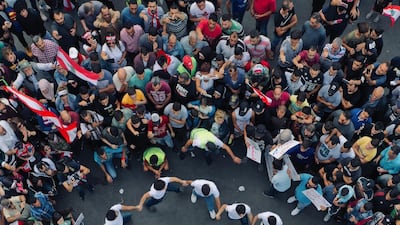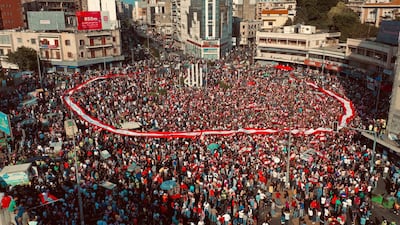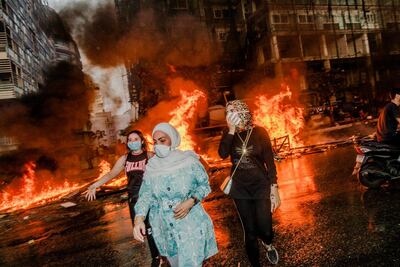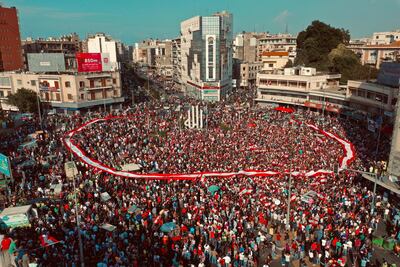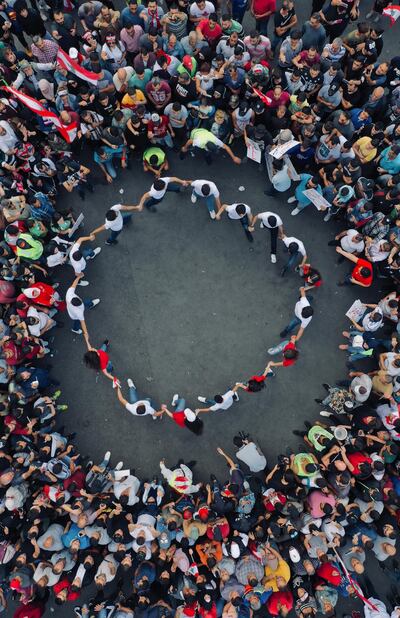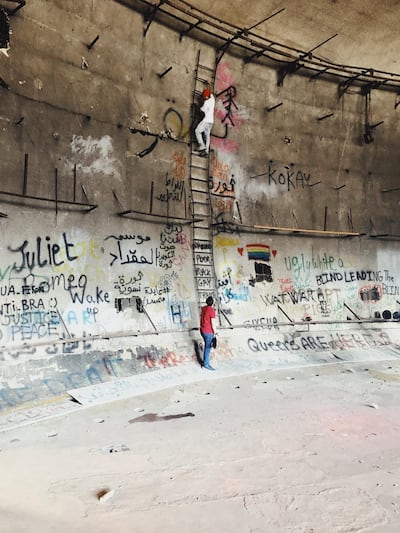If history, as it is said, is made up of many stories from several perspectives, then representations of Lebanon's current anti-corruption protests, offer a case in point. Photographers have always provided depictions from the frontline but in this instance, the demonstrations are not solely captured by photojournalists.
Artists and citizens are also shooting the mobilisations, exhibiting their work on social media platforms such as Instagram, eliciting mixed reactions.
Among those documenting the revolution is Myriam Boulos, a photographer best known for her studies of youth culture and interactions. Her pictures feature a range of shots, including documentary-style tableaux of young men and women partying. Her work captures her subjects' youthful abandon and vulnerability, at times approaching the poise of a Vogue spread.
On the evening of October 17, Boulos took her camera to the first night of the protests in downtown Beirut. Among her subjects was that night's most conspicuous demographic: young working-class men. It's a section of Lebanon's society who have been very affected by what triggered the protests in the beginning – proposed high taxes, in particular on free WhatsApp calls.
Boulos's camera captured myriad young men on scooters who blocked roads with burning rubbish bins, used construction site hoardings for kindling and methodically smashed the windows of banks and high-end businesses.
The mechanics of capturing this burgeoning occupation of Beirut's city centre and the demonstrations that have swelled since, are unlike those of her past practice, but the artist says the same compulsion moves her – "to question society, its people and my place among them, [and more recently] to resist society".
"This is how I take part in things," Boulos tells The National. "My pictures of the revolution, like my pictures in general, are my way of going through life. The only difference is that usually I take my time before showing the images. In this case everything is being done in the moment."
Time magazine picked up Boulos's Instagram pictures to illustrate its digital coverage of the unrest. The wide diffusion of images of bare-chested young men, some wearing scarves over their noses and mouths, won some praise – but more hate. Many condemned her showing the enthusiastic destruction of property because it made the protests look bad. But Boulos disagrees. "This violence was just a way of expression," she says. "It wasn't meant to hurt anyone. But Lebanese people are so obsessed with their image and representation. And in this thawra [revolution] everyone wanted to own it."
Boulos admits that her photos of the performative side of the protests – including the first night's destruction – reflect a similar sensibility to her artwork, but this is not simply a professional venture. "For me these pictures are not a project," she says. "It might become one with time, but for now … I am photographing as a Lebanese citizen taking part in the revolution in my own way."
Also capturing the turmoil as a citizen is Omar Imady, but his images seek to highlight the beauty amid the conflict. He has won admiration for his stills and videos capturing the spirit of gatherings in Tripoli's Nour Square in northern Lebanon. "I felt I owed it to my country, to come down with my drone to show everyone the beauty of this revolution," he says, "and show that the people attending it are humble, kind, democratic and, most importantly, united."
Imady isn't a professional photographer; by day he is a film producer, but he has also found success by selling his images. "I haven't shot the conflict that has troubled Tripoli in the past," he says, "but I have in my archive a lot of shots of Tripoli events such as festivals and weddings, so I positively covered different occasions showing the beauty of the city and the greatness of its people."
Imady's recent Instagram feed includes spectacular shots of Nour Square, ground-level photographs, drone-mounted pictures and videos, crowd shots and portraits. He says they all emerged from his sympathy for the demonstrations. "My previous work in festivals and big events has taught me to reflect the emotion of the group and the individual as well," he says. "But when you are emotionally involved and have passion for what you are capturing, you will be creative by default."
Imady wants to counter negative depictions of Tripoli with his work and wants to give his images of the revolution to the education ministry as a resource for a new Lebanese history textbook.
In Beirut, meanwhile, the field of protest portraiture has instead been dominated by journalists. For more than three weeks, Syrian-born photojournalist Ammar Abd Rabbo has used Martyrs' Square and the nearby Amin Mosque as a background for his "mobile studio," with demonstrators invited to stand on an improvised plinth for group shots. "I wanted to do something different," Abd Rabbo says. For him, the events presented an opportunity to capture the faces of the demonstrators, by taking them out of the crowd. "People might stop demonstrating, graffiti might be erased, but what will remain are the photos."
Maria Kassab's pictures of Beirut's protests are . The multimedia artist works extensively with photography – both her own pieces and those she has found – using them as canvases to create a whole new narrative. In the Le Naufrage series, for instance, she intertwines sea motifs with mundane photos of refugee families' personal effects. "My work is very much affected by the political climate," she says. "There's the instability, the spontaneity ... You always feel there's a lot of violence here, whether it's in politics or emotional violence among people. There's always this … 'tearing.'
“That’s probably why there’s a tearing in my work, the adding or removing or fixing something, to convey a theme of vandalism.”
Kassab returned from an artist residency in Brussels on October 17 and found Beirut in revolt. "This revolution has had different faces," she says. "The violent one and the festive one. I tried shooting both. I've also been shooting objects that were used in the violence."
Kassab's Instagram feed has blossomed with her series Objects of the Revolution," portrait-like shots of the detritus of the early days' fires, rubble and roadblocks.
In another mixed-media series, Letters From Home objects have been taken out of context and juxtaposed with an with ironic revolutionary slogans in Arabic. "I always go to demonstrations and take my camera to document what's happening," she says. "I'm not documenting as an outsider, but as someone who's involved.
"I've never felt like Lebanon is my home. I always want to leave. I always feel in exile. I've never felt I belong here, but when this happened … it was from the bones, you know? I had to be there. I felt, 'This is my home and I want to reclaim it.'"
Much like how her work is based on collage, Kassab’s perspective is now interwoven with that of her fellow photographers on Lebanon’s frontlines. Only time will tell how their work will shape history.
